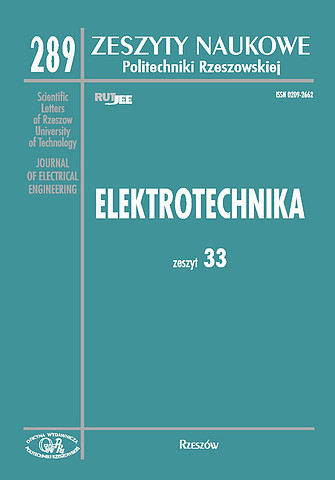Abstract
The paper presents results of simulation studies of four-phase 8/6 Switched Reluctance Machine working in steady-state. Simulation model of the machine was developed in Matlab/Simulink based on mathematical model. Simulation model was realized based on SimPowerSystems library, which contains for example models of semiconductor elements or power supplies. Controllable current sources and voltage measurement blocks were also used. Mathematical description of the machine is difficult to obtain in nonlinear circuit simulation models. Nonlinear flux characteristics ψ(θ, i) were obtained by field calculations and then were tabulated and used in circuit model of the machine. Studies were concerned the change of working point influence of motor on basic parameters especially on electromagnetic torque with various basic control methods (current control: soft-chopping and hard-chopping, voltage control: soft and hard, and one-pulse control). In current control was only used hysteresis regulator which held phase current at a certain level. Current control is possible to base speed, voltage control with its particular case called single-pulse control has wider use because it can be used above base speed, but for high-speed operation single-pulse control is used.
References
[2] Krishnan R.: Switched Reluctance Motor Drives: Modeling, Simulation, Analysis, Design, and Applications, CRC Press, 2001.
[3] Lobato P., Rafael S., Santos P., Pires A. J.: Magnetic Characteristics Modelling for Regular Switched Reluctance Machines: Analytical and FEM Approaches, Power Engineering, Energy and Electrical Drives, 2009, 60-65.
[4] Ramasamy G., Rajandran R.V., Saho N.,C.: Modeling of Switched Reluctance Motor Drive using Matlab/Simulink for Performance Analysis of Current Controllers, IEEE PEDS, 2005, 892-897.
[5] Carstensen C.E., Fuengwarodsakul N., De Doncker R.W.:Flux Linkage Determination for Correct Modeling of Switched Reluctance Machine - Dynamic Measurement versus Static Computation, Electric Machines & Drives Conference, 2007. IEMDC '07. IEEE International, Volume:2, 1317-1323.
[6] Ramanarayanan, V., Venkatesha, L., Debiprasad Panda: Flux-linkage characteristics of switched reluctance motor, Power Electronics, Drives and Energy Systems for Industrial Growth, 1996, 281-285.
[7] Bogusz P.: Silnik reluktancyjny przełączalny sterowany z procesora sygnałowego, Rozprawa doktorska, Warszawa 2003.
[8] Bogusz P., Korkosz M., Powrózek A., Prokop J.: Modelowanie pracy silnikowoprądnicowej napędu z maszyną reluktancyjną przełączalną, Przegląd Elektrotechniczny (Electrical Review), NR 12a/2012, str. 56-61.
[9] Powrózek A.: Model symulacyjny maszyny reluktancyjnej przełączalnej, Zeszyty Naukowe Politechniki Rzeszowskiej "Elektrotechnika" z. 32, 2012, 45-56.





